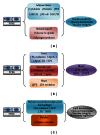Peroxisome proliferator-activated receptor targets for the treatment of metabolic diseases
- PMID: 23781121
- PMCID: PMC3678499
- DOI: 10.1155/2013/549627
Peroxisome proliferator-activated receptor targets for the treatment of metabolic diseases
Abstract
Metabolic syndrome is estimated to affect more than one in five adults, and its prevalence is growing in the adult and pediatric populations. The most widely recognized metabolic risk factors are atherogenic dyslipidemia, elevated blood pressure, and elevated plasma glucose. Individuals with these characteristics commonly manifest a prothrombotic state and a proinflammatory state as well. Peroxisome proliferator-activated receptors (PPARs) may serve as potential therapeutic targets for treating the metabolic syndrome and its related risk factors. The PPARs are transcriptional factors belonging to the ligand-activated nuclear receptor superfamily. So far, three isoforms of PPARs have been identified, namely, PPAR- α, PPAR-β/δ, and PPAR-γ. Various endogenous and exogenous ligands of PPARs have been identified. PPAR- α and PPAR- γ are mainly involved in regulating lipid metabolism, insulin sensitivity, and glucose homeostasis, and their agonists are used in the treatment of hyperlipidemia and T2DM. Whereas PPAR- β / δ function is to regulate lipid metabolism, glucose homeostasis, anti-inflammation, and fatty acid oxidation and its agonists are used in the treatment of metabolic syndrome and cardiovascular diseases. This review mainly focuses on the biological role of PPARs in gene regulation and metabolic diseases, with particular focus on the therapeutic potential of PPAR modulators in the treatment of thrombosis.
Figures



References
-
- Danaei G, Finucane MM, Lu Y, et al. National, regional, and global trends in fasting plasma glucose and diabetes prevalence since 1980: Systematic analysis of health examination surveys and epidemiological studies with 370 country-years and 2·7 million participants. The Lancet. 2011;378(9785):31–40. - PubMed
-
- World Health Organization. Global Status Report on Noncommunicable Diseases. Geneva, Switzerland: 2010.
-
- Cameron AJ, Shaw JE, Zimmet PZ. The metabolic syndrome: prevalence in worldwide populations. Endocrinology and Metabolism Clinics of North America. 2004;33(2):351–375. - PubMed
-
- Isomaa B, Almgren P, Tuomi T, et al. Cardiovascular morbidity and mortality associated with the metabolic syndrome. Diabetes Care. 2001;24(4):683–689. - PubMed
-
- Coll T, Rodríguez-Calvo R, Barroso E, et al. Peroxisome proliferator-activated receptor (PPAR) β/δ: a new potential therapeutic target for the treatment of metabolic syndrome. Current Molecular Pharmacology. 2009;2(1):46–55. - PubMed
Publication types
MeSH terms
Substances
LinkOut - more resources
Full Text Sources
Other Literature Sources
Medical

